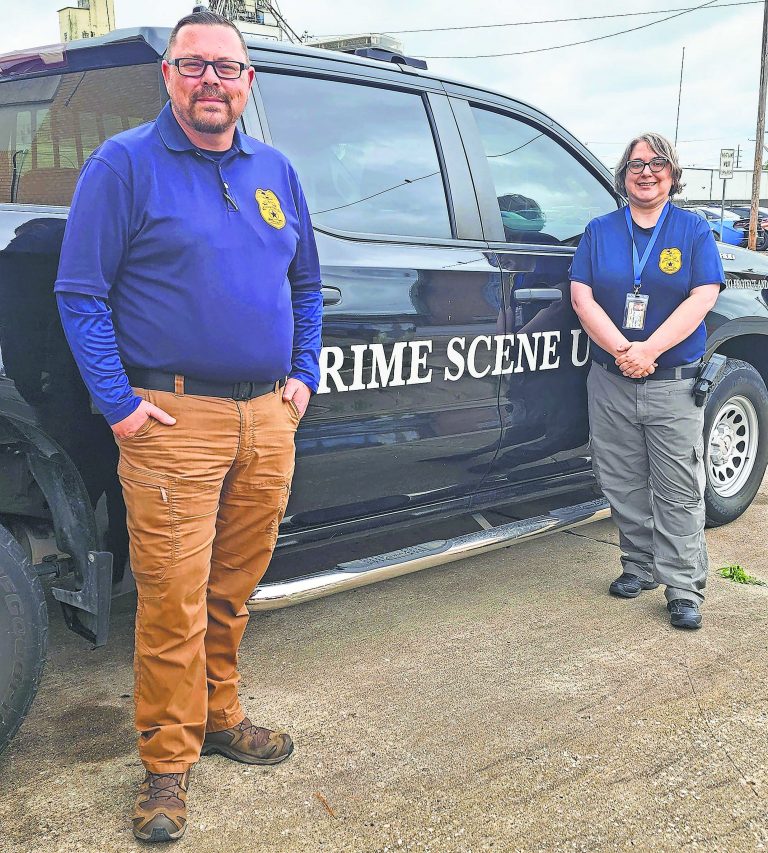By Michael Pineda
mpineda@cherryroad.com
Ardmore is unique among communities its size in that it has a Crime Scenes Unit.
For Julia Roberts and Grady Dickinson, CSI is more than evening entertainment on the television, it is a way of life. They are tasked with being available at all hours of the day to investigate crimes that can range from property to homicide.
“It kind of blew my mind when I came here and they had a CSI two-person team,” APD Chief David Houser said. “In the past, with any other agency, OSBI is the people you call. Ardmore doesn’t have to call OSBI unless it is an outsourced officer-involved call. Grady and Julia can do it all.
“It is an immediate response. You call OSBI and they are probably a minimal of 30 minutes out. And another benefit is they get to work directly with the investigators as well. They can share the information in real time.”
Roberts has been with Ardmore’s CSI for 15 years. She attended Oklahoma State University, majoring in biology. She had taken a class in forensics and was looking for a job when the Ardmore opportunity presented itself.
“I thought it was interesting and found out Ardmore was hiring,” she said. “So, I came here, got the job and have been here ever since. I kind of stumbled into it but I don’t regret it. I have really enjoyed my time here.”
Dickinson, on the other hand, took a path directly leading to the crime scene unit. He went to the University of Central Oklahoma. He graduated with a bachelor’s degree in forensics and criminal justice when he began looking for a job.
“I was offered a position here,” he said. “I was a bit of a true crime nerd anyway.”
The learning curve
When Roberts arrived in Ardmore, she did not realize how much was involved with the job, especially in a town this size despite having grown up here.
“I knew we had some crime here, but I did not realize the variety of cases that I would be working and the type of skills I would be needing on a day-to-day basis,” she said.
Roberts said there has been ongoing education for her and Dickinson. She said Ardmore is only one of a handful of units that have an accredited laboratories for latent print analysis in the state.
“The others I know of are Oklahoma City, OSBI and Tulsa,” she said. “That is something kind of special that we have here, but it took a lot of training and a lot of practice before I was able to do that. Probably, at least, two years’ worth.”
Dickinson said that he was unaware that Ardmore had a crime scene unit when he began looking for a job and that he was also surprised about the variety of crimes he would investigate.
“We have the typical property crime-type stuff but also the homicides, the assaults and those kinds of things,” Grady said.
Just over the past weekend, Roberts responded to a suicide with shots fired, collecting shell casings and everything in between.
Dickinson said the biggest difference between reality and what you see on television is the time involved to investigate a scene. It takes longer than 30 minutes.
“Where a lot of times, especially in the CSI shows, they will come into a scene, kind of do a little glance around, pull out the powder and the brush, will hit one spot and it is like a perfect fingerprint,” he said. “It doesn’t really work like that in real life.”
Roberts said the tools you see used on television exist, but it doesn’t work the same way, and typically are more involved and a lot slower than you see on television.
Comes with the territory
As part of the two-man crime scenes unit, someone must always be on call. Dickinson said the job is 24/7, 365 days a week and that he and Roberts switch being on call every week.
“You can’t really go out of town,” Roberts said. “But you kind of get used to it after a while.”
Roberts said she has pets and hangs out with them and her parents. She also reads a lot of horror.
Dickinson said you have to be more efficient with your time. When not working, he likes to relax with his wife and dogs, spending a lot of time hiking. He also enjoys watching a lot of true crime shows.
“I also have a pretty firm grounding in my faith, and I think that helps a lot too,” he said. “Especially when you are talking about the more difficult things you might have to deal with.”
When working a scene, Dickinson said he enjoys the challenges that come with the job.
“Every scene is kind of its own unique experience and I enjoy that challenge, having to adjust to the circumstances as they present themself and try to acquire some physical evidence that can help our investigation and our detectives get to the root source of what is going on,” he said.
Roberts said she likes the people she works with from Dickinson, past co-workers to the detectives and district attorney’s office.
Those relationships are important in working a case. Dickinson said information is shared quicker being in the same building.
“That can allow if we need to pivot on an investigation or readdress something,” Grady said. “That conversation can happen a lot quicker.”
Sgt. Matt Dunn said Dickinson and Roberts also play a key role in helping the department and administration keep track of technology in specific areas.
“Having somebody dedicated to it, they are able to bring that to us and say there is new technology here or they are moving to these areas,” Dunn said. “It streamlines and keeps the department up to date.”
Roberts said there have been some changes in the past 15 years which includes the field of DNA. Ardmore can do more with DNA on property crimes than it did when she started and the turnaround time with the OSBI and medical examiner is faster.
“It hasn’t changed a great deal, but it has gotten faster and easier,” she said. “Things that can be done with technology, like computers and cell phones and stuff like that have improved quite a bit.”




